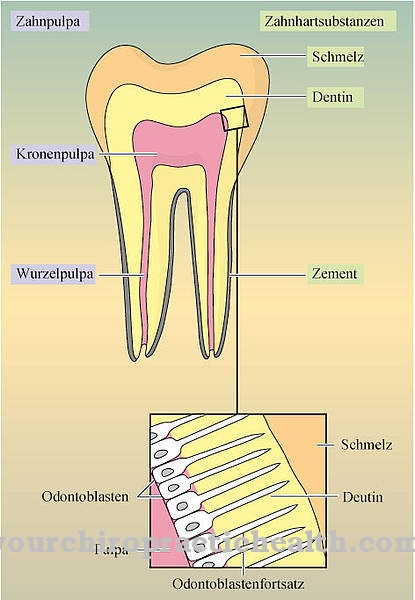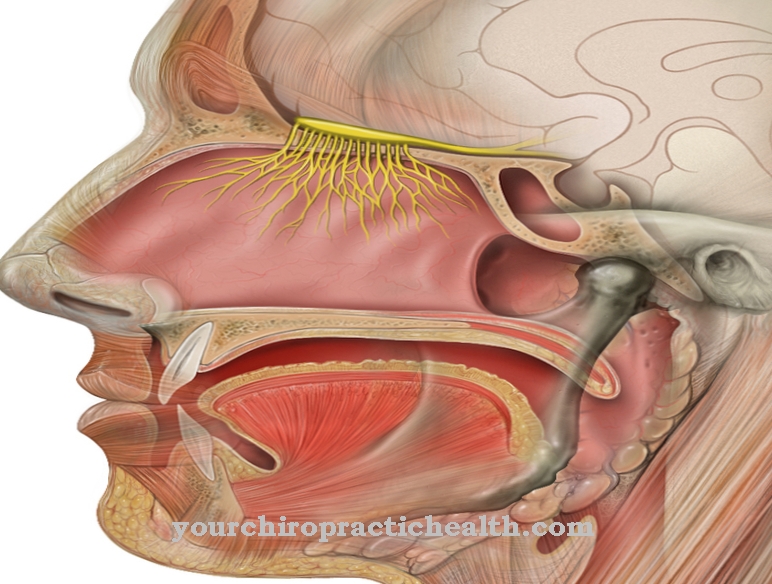Of the Corpus ciliary is also known as Ciliary body or Radiant body and is located in the middle skin of the eye. It is used for accommodation, aqueous humor production and lens suspension. If the suspension fibers of the lens tear in an accident, the lens may slip out of the restraint of the ciliary body in a lens dislocation.
What is the corpus ciliare?
The physician understands the corpus ciliary or ciliary body to be the radiating body of the middle skin of the eye. The lens, among other things, is suspended from this section of the eye. The corpus ciliare takes on important tasks in the near and far adjustment within the framework of the visual process.In addition to connective tissue and nerves, the ciliary body also contains muscles, vessels and glands.
The muscles and glands of the ciliary body are also known as the ciliary muscles and ciliary glands. The choroid merges with the so-called "sawn edge" into the steel body, which arches inwards towards the lens like an annular bulge. The ciliary processes at the apex of the corpus ciliare are also known as the ciliary ring and are held at the lens equator.
This is where so-called zonula fibers originate, all of which doctors call zonula ciliaris. The lens is clamped to the zonula ciliaris. The entire system around the ciliary body merges forward into the iris.
Anatomy & structure
The radiating body of the eye is covered by the pars ciliaris retinae. This is a layered epithelium that belongs to the retina. Inside the ciliary body, the ciliary muscle is embedded, which consists of smooth muscles and is used to clamp the lens. This ring-shaped muscle is connected to the ciliary gland, which produces the aqueous humor, via suspension fibers.
The oculomotor nerve or third cranial nerve grows through the ciliary muscle. The radiation body itself consists of pigmented, loose and collagenous connective tissue, which is supplied with blood through the windowed steel body capillaries. The corpus ciliare receives its general sensitivity from the Nervi ciliares longi et breves.
Function & tasks
Without the ciliary body, people would not be able to see, or rather only very blurred. In addition to suspending the lens, the corpus ciliare is used for accommodation for near and far vision as well as for the production of aqueous humor. In terms of accommodation, the ciliary body participates in perceptions at distances above and below five meters. This threshold is the boundary between near and far vision.
During close fitting, the ciliary muscle contracts and thus narrows the inner circumference of the radiating body. The ciliary fibers that hold the lens in place then relax. The inherently elastic lens takes on the shape of a sphere. It reduces its radius of curvature and through this transformation also increases its own refractive power. The reverse process occurs with remote fitting. The ciliary muscle relaxes when there is visual perception at distances of over five meters. The hanging fibers of the lens then expand. They tighten and thus deform the lens against its inherent elasticity until it has taken on a flattened shape.
In addition to these effects of the lens setting, the unpigmented cells of the radiation body are primarily involved in the production of aqueous humor. The ciliary gland produces two millimeters per minute of this clear, cell-free secretion, which is 99 percent water. The remaining percentage is made up of electrolytes, immunoglobulin G, ascorbic acid and amino acids, lactic acids, hydrogen peroxide and glutathione. This aqueous humor is used to nourish the lens and cornea.
Apart from that, it keeps the eyeball in shape and builds up intraocular pressure. The unpigmented tissue of the corpus ciliare plays a role in the production of aqueous humor insofar as its enzymes serve to hydrate carbon dioxide to carbonic acid and vice versa.
You can find your medication here
➔ Medicines for eye infectionsDiseases
One of the most well-known diseases that may be associated with a ciliary body defect is glaucoma. For example, an increase in intraocular pressure significantly increases the risk of glaucoma and, in extreme cases, irreparable blindness. An overproduction of aqueous humor is often responsible for an increase in intraocular pressure, as can occur in the context of diseases of the ciliary gland or disturbed drainage channels.
Turbidity of the aqueous humor can also be possible. Such complaints mainly occur when the ciliary body is inflamed. If the anterior structures of the eye are inflamed, a painful spasm of the ciliary muscle can occur in addition to clouding the aqueous humor. Often, as a result of such a disease, accommodation can no longer take place.
If the eye is affected by accidents, the zonular fibers of the ciliary body system, on which the lens is suspended, may also tear. If the collecting fibers of the ciliary system are damaged, lens dislocation can occur. Such a lens dislocation is used when the lens is displaced into the anterior chamber or the vitreous humor. In rare cases, a malignant tumor forms in the ciliary body. Such a choroidal melanoma is incurable in the metastatic stage.
Choroidal melanomas usually grow very slowly, so that they are often associated with no or only subtle symptoms for a long time. Genetics probably play a decisive role in the fatal metastasis in choroidal melanoma. The chances of recovery from ciliary melanoma without metastases depend primarily on the location and size of the tumor.













.jpg)

.jpg)
.jpg)











.jpg)